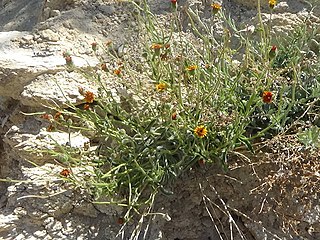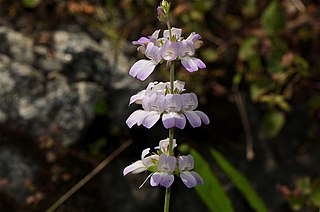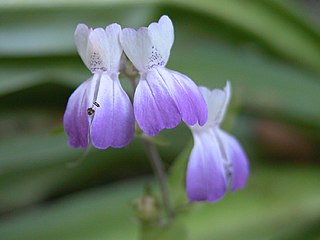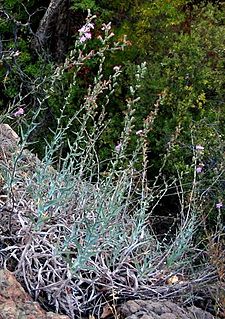
Collinsia is a genus of about 20 species of annual flowering plants, consisting of the blue eyed Marys and the Chinese houses. It was traditionally placed in the snapdragon family Scrophulariaceae, but following recent research in molecular genetics, it has now been placed in a much enlarged family Plantaginaceae.

Collinsia heterophylla, known as purple Chinese houses or innocence, is a flowering plant native to California and the Peninsular Ranges in northern Baja California.

Nolina parryi is a flowering plant that is native to Baja California, southern California and Arizona.

Collinsia parviflora is a species of flowering plant in the family Plantaginaceae known by the common names maiden blue eyed Mary and small-flowered collinsia.

Hulsea vestita is a species of flowering plant in the family Asteraceae known by the common name pumice alpinegold.
Allium parryi is a North American species of wild onion known by the common names Parry's onion and Parry's fringed onion. It is common in the Coast Ranges of southern California and northern Baja California. It is also known from the southernmost reaches of the Sierra Nevada.

Ceanothus parryi, with the common name Parry ceanothus, is a species of shrub in the buckthorn family Rhamnaceae. It is native to Oregon and northern California, where it grows in the canyons of coastal mountain ranges.

Collinsia bartsiifolia is a species of flowering plant in the plantain family known by the common name white blue-eyed Mary.

Collinsia childii is a species of flowering plant in the plantain family known by the common name Child's blue-eyed Mary.

Collinsia concolor is a species of flowering plant in the plantain family known by the common name Chinese houses.
Collinsia corymbosa is a species of flowering plant in the plantain family known by the common name round-headed Chinese houses. It is endemic to the coastline of California north of the San Francisco Bay Area, where it is uncommon and scattered. Its habitat is the sand dunes of the immediate coastline. This is an annual herb producing a scaly, hairy, red to reddish green stem which grows upright or decumbent to a maximum length of about 25 centimeters. The thick, sparsely hairy leaves are rippled and lobed along the edges, which may be somewhat turned under. The inflorescence is a dense whorl of several distinctive flowers. Each has a hairy calyx of lobed reddish sepals and a corolla up to about 2 centimeters long. The flower has two small upper lobes and three longer lower lobes which come together in a nearly tubular shape. It is generally white with a light purple tint. The smaller upper lobes curl back and dry to brown at their lips.
Collinsia greenei is a species of flowering plant in the plantain family known by the common name Greene's blue-eyed Mary.
Collinsia linearis is a species of flowering plant in the plantain family known by the common name narrowleaf blue-eyed Mary.

Collinsia multicolor is a species of flowering plant in the plantain family, known by the common names San Francisco blue eyed Mary and San Francisco collinsia. It is endemic to the San Francisco Bay Area, where it is known from San Francisco to Santa Cruz. As of 2008 there are 22 known occurrences. Populations south of Santa Cruz have been extirpated.

Collinsia verna, or blue-eyed Mary, is a winter annual that is native to the eastern and central parts of North America but has become endangered in the states of New York and Tennessee. The flowers are bicolored white and blue. It is a plant of valley bottoms and moist bottom slopes, in areas with moderate lighting and requires some shade.

Eriodictyon parryi or poodle-dog bush is a tall California mountain shrub with showy purple flowers, which is notable for secreting a severe skin irritant. It is an opportunistic species that grows mostly in areas that have been disturbed by fire. In a dry early spring in Southern California, its semi-dormant leaves can droop and curl into coils like locks of curly hair, hence the popular name based on the metaphor of a poodle's natural hair.

Stephanomeria cichoriacea is a species of flowering plant in the aster family; it is known by the common names chicoryleaf wirelettuce and silver rock-lettuce. It is endemic to California, where it grows in the coastal mountain ranges as far north as Monterey County, but especially in southern California mountains such as the Transverse Ranges. Its habitat includes chaparral. It is a perennial herb producing slender erect stems reaching maximum heights exceeding one meter. The stem is woolly with hairs, especially on new growth. The leaves are mostly located in a basal rosette, the largest reaching 18 to 20 centimeters long. They are lance-shaped and often toothed along the edges, and the newer ones are woolly. Smaller leaves occur farther up the stem. The inflorescence is a long array of several flower heads, with some occurring in the upper leaf axils as well. Each head has a cylindrical base 1 to 2 centimeters long which is lined with layers of glandular phyllaries. The head contains 10 to 15 ray florets, each with an elongated tube and a pink ligule which may be up to 2 centimeters long. The fruit is an achene tipped with a spreading cluster of long, plumelike pappus bristles.
Stephanomeria parryi is a species of flowering plant in the aster family known by the common name Parry's wirelettuce. It is native to the southwestern United States, where it grows in many types of habitat, including many desert areas. It is a perennial herb growing from a thick root and producing one or more slender, upright stems up to about 40 centimeters tall. The green leaves are linear to lance-shaped with lobed edges and are up to 8 centimeters long near the base of the plant. Flower heads occur on the spreading branches. Each has up to 13 or 14 ray florets, each with an elongated tube and a whitish ligule up to 1.5 centimeters long. The fruit is an achene tipped with a spreading cluster of long, tan, plumelike pappus bristles.

Ziziphus parryi is a species of flowering plant in the buckthorn family known by the common name Parry's jujube.
Flyriella parryi, the Chisos Mountain brickellbush, is a Mexican species of plants in the family Asteraceae. It is native to the states of Nuevo León, Coahuila, and Chihuahua in northern Mexico. It is the only species in its genus to have a natural range extending north of the international border, with a few populations on the Texas side of the Río Grande.















